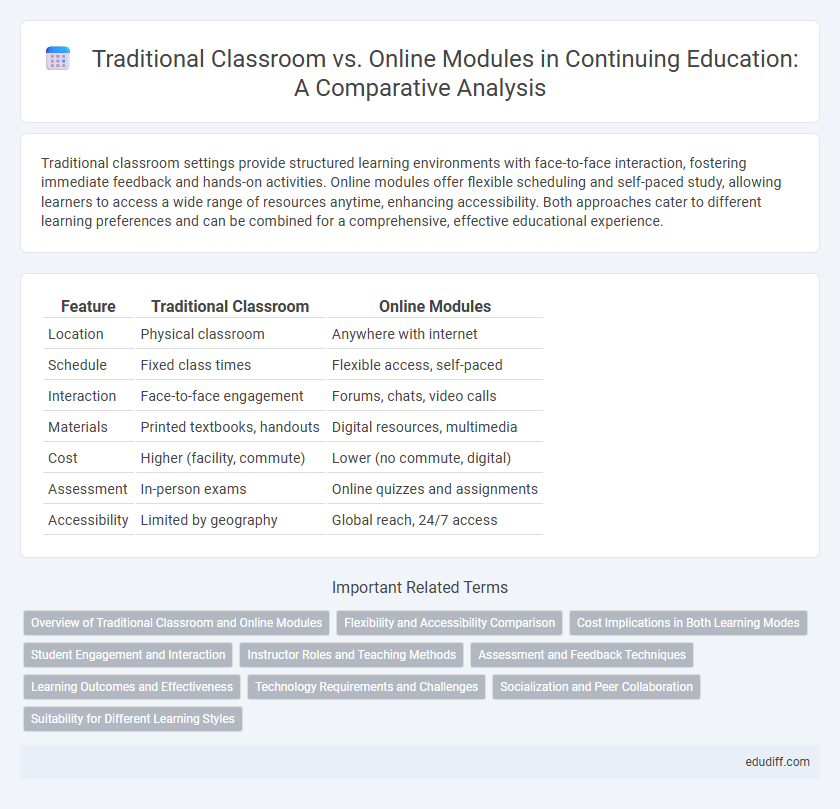Traditional classroom settings provide structured learning environments with face-to-face interaction, fostering immediate feedback and hands-on activities. Online modules offer flexible scheduling and self-paced study, allowing learners to access a wide range of resources anytime, enhancing accessibility. Both approaches cater to different learning preferences and can be combined for a comprehensive, effective educational experience.
Table of Comparison
| Feature | Traditional Classroom | Online Modules |
|---|---|---|
| Location | Physical classroom | Anywhere with internet |
| Schedule | Fixed class times | Flexible access, self-paced |
| Interaction | Face-to-face engagement | Forums, chats, video calls |
| Materials | Printed textbooks, handouts | Digital resources, multimedia |
| Cost | Higher (facility, commute) | Lower (no commute, digital) |
| Assessment | In-person exams | Online quizzes and assignments |
| Accessibility | Limited by geography | Global reach, 24/7 access |
Overview of Traditional Classroom and Online Modules
Traditional classrooms offer structured, face-to-face instruction with direct interaction between teachers and students, facilitating immediate feedback and collaboration. Online modules provide flexible, self-paced learning through digital platforms, enabling access to diverse multimedia resources and asynchronous communication. Both methods emphasize curriculum delivery but differ in accessibility, engagement dynamics, and resource integration.
Flexibility and Accessibility Comparison
Traditional classrooms often require fixed schedules and physical attendance, limiting flexibility for students balancing work or family commitments. Online modules offer 24/7 access to course materials, enabling learners to study at their own pace from any location with internet connectivity. This accessibility supports diverse learning needs, making education more inclusive for individuals with mobility issues or geographic constraints.
Cost Implications in Both Learning Modes
Traditional classroom learning typically incurs higher costs due to expenses such as physical infrastructure, commuting, and printed materials, which elevate overall tuition fees. Online modules reduce these expenses by eliminating the need for physical space and allowing digital distribution of resources, making them more cost-effective for both institutions and students. However, hidden costs in online education include technology investments and potential fees for software licenses or high-speed internet access.
Student Engagement and Interaction
Traditional classrooms foster face-to-face interaction, promoting immediate feedback and collaborative learning through group discussions and hands-on activities. Online modules leverage multimedia tools and interactive platforms to enhance engagement, allowing students to participate at their own pace and access diverse resources. Both methods impact student engagement differently, with traditional settings favoring direct social interaction and online modules offering flexibility and varied instructional approaches.
Instructor Roles and Teaching Methods
In traditional classrooms, instructors primarily lead face-to-face discussions, facilitate hands-on activities, and provide immediate feedback to address student questions, fostering a collaborative learning environment. Online modules require instructors to design engaging multimedia content, utilize asynchronous communication tools, and implement adaptive assessments to support self-paced learning effectively. Both teaching methods demand instructors to continuously assess student progress and adjust their strategies to optimize learning outcomes.
Assessment and Feedback Techniques
Assessment and feedback techniques vary significantly between traditional classrooms and online modules, with traditional settings relying on in-person examinations, quizzes, and direct teacher evaluations. Online modules utilize automated grading systems, real-time analytics, and personalized feedback through digital platforms, enhancing timely responses and adaptive learning paths. These digital tools enable detailed tracking of student progress and customized interventions that are less feasible in conventional classroom environments.
Learning Outcomes and Effectiveness
Traditional classrooms provide face-to-face interaction that fosters immediate feedback and social learning, enhancing comprehension and retention. Online modules offer flexible pacing and multimedia resources that cater to diverse learning styles, often improving accessibility and engagement. Studies indicate blended approaches combining both methods yield higher learning outcomes and overall effectiveness.
Technology Requirements and Challenges
Traditional classrooms typically require basic technological infrastructure such as projectors and computers, allowing for direct instructor-student interaction without dependence on internet connectivity. Online modules demand robust internet access, compatible devices, and user-friendly learning management systems to facilitate seamless content delivery and real-time engagement. Challenges in online education arise from bandwidth limitations, technical support gaps, and varying digital literacy among learners, impacting the overall effectiveness of virtual instruction.
Socialization and Peer Collaboration
Traditional classrooms foster direct social interaction and spontaneous peer collaboration, enhancing communication skills and group dynamics through face-to-face activities and discussions. Online modules offer flexible collaboration opportunities via forums, video calls, and shared digital workspaces, but may lack the immediacy and nonverbal cues essential for deep social bonding. Studies show that while online learning can support peer interaction, the richness of in-person socialization in traditional settings often leads to stronger teamwork and relationship-building.
Suitability for Different Learning Styles
Traditional classrooms provide structured environments suited for kinesthetic and social learners who benefit from face-to-face interaction and hands-on activities. Online modules cater to visual and auditory learners by offering multimedia content that can be accessed anytime, supporting self-paced and individualized study. Interactive elements like quizzes and forums in online platforms enhance engagement for diverse learning preferences.
Traditional Classroom vs Online Modules Infographic

 edudiff.com
edudiff.com